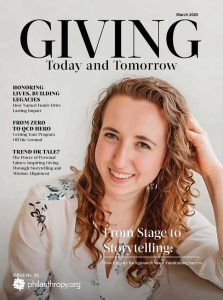
Emily Wills
Development Director
Madison Reading Project
Madison, Wisconsin

What tips from theater would you share for overcoming fear in major donor meetings?
I learned so much from my theater days. Having done both scene work with a script in front of me and improv with no script, I recommend writing a “script” before going into any major donor meetings. For me, that script is usually a bullet-point list of topics that I want to cover and important information about the donor and their giving history. Having a “practice” conversation with a friend or colleague beforehand is really helpful too.
How does developing your characters in theater translate to understanding and connecting with diverse donor motivations?
Any time you’re preparing a character, thinking about their motivations, hopes, and desires, and imagining what tactics they might use to achieve them is very important. Similarly, understanding a donor’s motivations requires you to understand where they are coming from – why they give, what they hope to accomplish with their gift, and how they are most comfortable being communicated with. A career in fundraising requires so much empathy, which is exactly what a background in theater and the arts prepares you for.
Improvisation is key in live performance. How can fundraisers use improv skills to navigate unexpected situations, like tough donor questions?
I think a great way to approach developing those tough conversation skills is to practice them with a fundraising colleague. I’ve had friends ask if they can practice their phone call script with me over the phone and it was really helpful in understanding what questions a donor might have or how silence might make you feel in a tense moment and practice how you want to respond. The best part about doing these practice sessions with a trusted colleague is being able to ask for feedback and make adjustments to your “script” before going in to make the real donor call.
How has your theater background influenced the way you use storytelling in your career?
My theater background incorporated both performance skills and back-stage experience as a director, designer, and stage manager. I spent many years working in a box office in Chicago and paid attention to each attendee’s experience from their ticket purchase, entering the theater, through the end of the performance. Storytelling happens on both sides – the person telling the story and the person interpreting what they’ve been told. I adore stories and love to think about how we share information, what format makes the most sense, and how we can convey impactful information. My preference is to diversify the kinds of communication we send to our donors with written, text-heavy communications blended with more info-graphic or illustrative communications. I think the way that information is shared is just as important as what is shared and can change how donors experience their giving for better or for worse.
Has your work in literacy given you any inspiration in ways to share information with our stakeholders more effectively?
I spent several years as a teaching artist working in and out of classrooms to help young people develop their storytelling and performance skills. Sharing knowledge has become one of my absolute favorite parts of development work. Whether it is mentoring a new fundraiser just entering the field or scaffolding information into a donor welcome series to introduce them to an organization’s mission and impact, I love sharing information that helps people grow.
Fortunately, so many of our supporters are book nerds and believe strongly in the value of literacy. Unfortunately, literacy rates for children in the communities we serve have been severely impacted by pandemic learning, lack of funding, and a poor understanding of how learning to read really happens. I try to approach this challenge by empowering our donors and supporters to understand the barriers children are facing and how we can help support them to become confident readers.
Fundraising requires both creativity and data analysis. How do you balance the “art” of storytelling with the “science” of donor metrics?
I won’t lie, there are some days that I have to put on noise cancelling headphones and just dive into data. Having a CRM that can pull the reports you need, or automatically display valuable information has been really helpful (we use Bloomerang). In general, I try to keep an eye on our donor metrics without letting them take over my brain space. Since so much is calculated on a quarterly or annual basis, I try to keep my main focus on my annual development plan for the year and check in on metrics to compare them to years past as we go.
Are there any insights from a book -fiction or nonfiction – that you’ve incorporated into your work?
This is such a good question! A couple of books that have really helped me shape the way I approach work and my thought patterns (although I can’t think of specific take-aways off the top of my head!) are 101 Essays That Will Change the Way You Think, by Brianna Wiest and The Crossroads of Should and Must by Elle Luna.
Frankly, when I started on the path to being a fundraiser I felt a lot of sadness at leaving the arts world behind. Being an actor and an educator had been such a key part of my identity for so long that the transition away from having that be my main focus was really challenging. What drove the shift, for me, were my other priorities – I wanted a stable work/life balance that would give me time to spend with family and friends, and my husband was entering grad school, so I was preparing to take on the “main breadwinner” role for our family.
While the transition was hard, it has ultimately led me to a really happy spot both in my personal and professional life.
What advice would you give to young fundraisers starting their careers today?
Find a mentor! Your local AFP (Association for Fundraising Professionals) may have a mentorship program, or you can seek out someone within your organization. Having someone to go to with questions who isn’t your direct supervisor can be really freeing and provide you space to develop an important relationship with someone who is experienced in the field.
No matter how much experience you have, you cannot know everything. I think fundraising requires a combination of planning and preparing for the unexpected. There is no such thing as “perfect,” so focusing on what you can do to connect with people as individuals is ultimately the most important thing we can do.
The money is important, but the people and relationships are more important. Do your best not to base your merit on dollars alone. Every phone call, thank you note, impact report, and in-person meeting is equally important and impactful.
From your mid-career perspective, what innovations or trends do you think will define the field in the next decade?
I’m very curious to see how AI changes the landscape for donor interactions. Personally, I am reluctant to hand tasks over to a bot – especially the aspects of fundraising that I really enjoy like writing copy for donor communications!
The pandemic really changed our personal interactions and expectations for how we connect. Gathering in-person can still make some people uncomfortable, even though I think face-to-face conversations are the most impactful. As technology continues to change and shape our world, I hope that we as a sector can retain some more human touchpoints.
There is something really special about receiving a handwritten note delivered physically in the mail, having a thank you basket delivered to your door, or being invited to share a meal.
The changes that I would like to see personally involve how we define our relationships with donors and set their expectations for interaction. At its core, fundraising—like theater, literacy, and all creative disciplines—is about connection, storytelling, and empowering others. When we bring the same empathy, adaptability, and commitment to meaningful communication that define the arts, we build deeper relationships and create lasting impact.